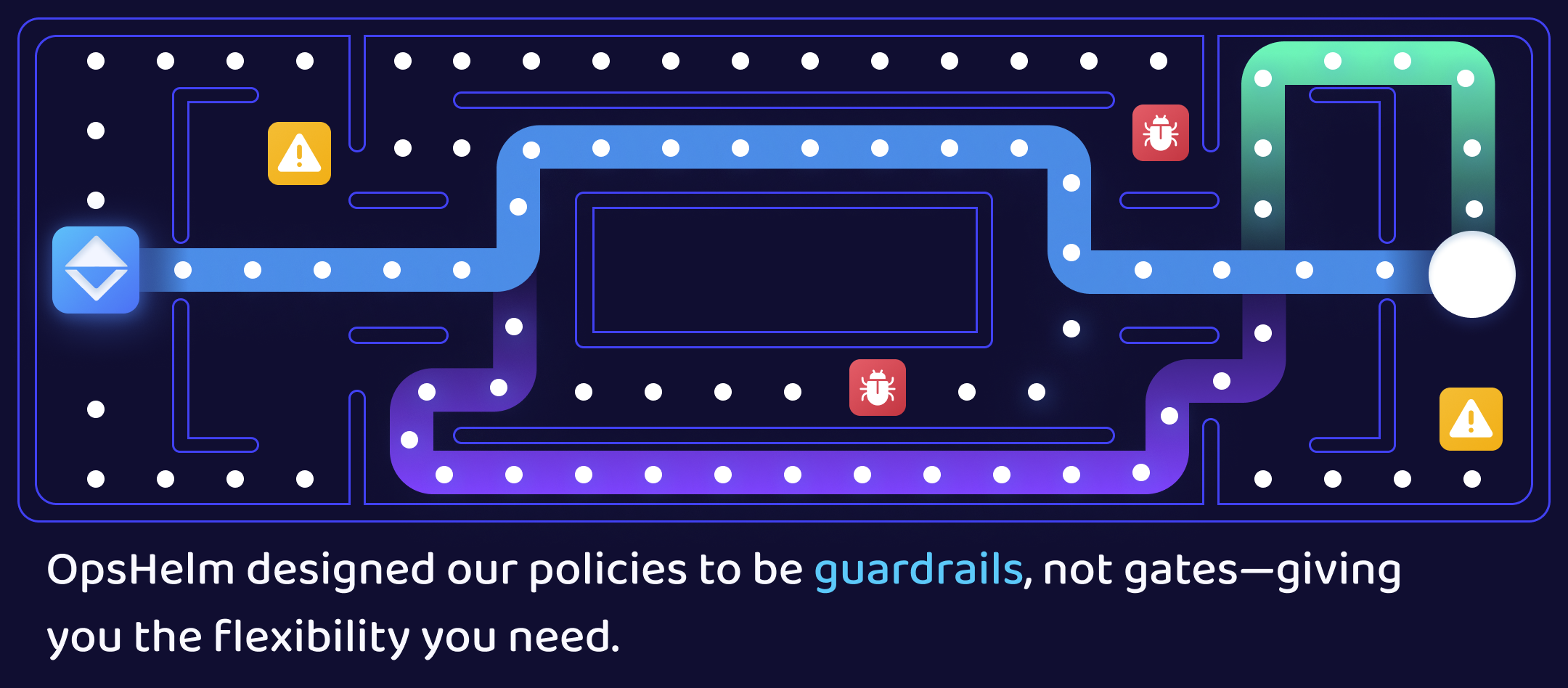OpsHelm for Ops

My Experience in Operations
Working in operations can be stressful. If you, like me, have worked in operations (e.g. on a platform, infrastructure, or DevOps team), you probably know this story all too well. You are mid-sprint either standing up something new or doing some routine maintenance work—when you get a Slack message from your security team. It appears you triggered some sort of security alarm which must be addressed, but in the meantime your progress is dead in the water.
It’s not always obvious why security is receiving alerts. Is the issue in the new AWS environment we spun up in Europe, is it the new research app that the R&D team have been deploying, or a vulnerable library that’s been included somewhere? It takes time to find out what went wrong and it takes even more time to fix it. Once the root cause is identified, you need to roll out a fix that doesn’t break anything else. This process can take hours, or weeks in some cases, and it’s all a major distraction from typical work that you’re doing. Security hygiene is important, but it is also inherently an interruption to daily operations work.
It’s easy to get frustrated and blame the security team for just being a nuisance, and standing in the way of you getting your job done. However, it’s not necessarily easier on them. They get alerts from your activity, and then most likely must convince others to take the problem seriously until it’s fixed. They can run over “hair on fire” only a few times before the ops team dismisses their urgency like they would a daily fire drill. Meanwhile, security doesn’t have direct access to the systems you and your team are managing. They also lack the context about what you’re working on and why, meaning they can’t fix the issues themselves.
For operations professionals, security is often a speed bump for progress for as long as remediation is part of the job. Regardless of who is running security at a given organization, their job inherently conflicts with that of the operations department. It’s the age-old conundrum of innovation vs. security.
Where Existing Solutions Fall Short for Ops
Security teams are inundated with tools that do logging, alerting and risk prioritization. But flagging risks only solves part of the problem, and continues to stymie operations. For a new tool to legitimately reduce the security burden currently being put on operations departments, it needs to automatically remediate exposures as well—in a non-disruptive way.
The tools available today simply do not go far enough to take the workload off of employees’ plates, nor do they offer the flexibility needed for varied infrastructure environments. For example, Hashicorp’s Sentinel will integrate with Terraform that will detect and report exposed misconfigurations, but they have very specific “best practices” – and you’re subject to them.
Meanwhile, developing your own best practices takes a lot of trial and error. And even when you do get a decent set of upfront configurations and policies, getting someone onboarded and up to speed on them can take a long time. If you have suboptimal policies or your whole team isn’t on the same page about them, you’re starting out at a disadvantage.
How OpsHelm Works to the Benefit of Ops

At OpsHelm we did the hard work upfront to create a secure set of default policies for cloud environments, but with one extremely important twist:
We designed our policies to be guardrails, not gates—giving you the flexibility you need.
We provide a sane set of default policies without any upfront work required from you. With just a few clicks, you can implement a proper system of best practices and verify that your entire network complies with these best practices—without breaking any existing features.
Even better, the ops team gets instant feedback as soon as a misconfiguration is spotted: as soon as something is deployed, I know if it’s safe for the company or not. If it violates one of the guardrails,the ops team will hear from OpsHelm immediately. They don’t have to wait for a security engineer to triage a bunch of alerts and get to me after I’ve moved onto the next thing and no longer have context top-of-mind. Getting the context of a security exposure in real-time is far more helpful than trying to fix something you last worked on weeks or months ago.
Consider OpsHelm a partner to you as you ship new code, infrastructure, tooling—and guiding you to make it more secure. We’re doing what we can to bring that automation you’re used to in an operations environment, to the security space. Something that’s been missing for a while. (Expect another post on that at a different time.)
If you’re in operations use OpsHelm’sm existing guardrails and automation to make your life easier—and free up your work schedule from repeatable maintenance tasks so you can focus on what matters most: growing the business.
See our product in action and discover how it can change your Ops and Security approach, schedule a demo.


